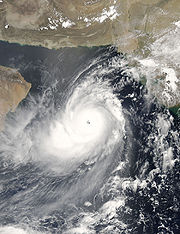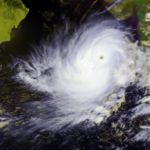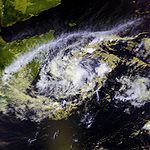
Tropical cyclones in the Arabian sea
Encyclopedia

Indian Ocean
The Indian Ocean is the third largest of the world's oceanic divisions, covering approximately 20% of the water on the Earth's surface. It is bounded on the north by the Indian Subcontinent and Arabian Peninsula ; on the west by eastern Africa; on the east by Indochina, the Sunda Islands, and...
, which is the third largest ocean in the World.
the Indian Ocean is the warmest ocean in the world. The Arabian Sea's coast is shared among India
India
India , officially the Republic of India , is a country in South Asia. It is the seventh-largest country by geographical area, the second-most populous country with over 1.2 billion people, and the most populous democracy in the world...
, Yemen
Yemen
The Republic of Yemen , commonly known as Yemen , is a country located in the Middle East, occupying the southwestern to southern end of the Arabian Peninsula. It is bordered by Saudi Arabia to the north, the Red Sea to the west, and Oman to the east....
, Oman
Oman
Oman , officially called the Sultanate of Oman , is an Arab state in southwest Asia on the southeast coast of the Arabian Peninsula. It is bordered by the United Arab Emirates to the northwest, Saudi Arabia to the west, and Yemen to the southwest. The coast is formed by the Arabian Sea on the...
, Iran
Iran
Iran , officially the Islamic Republic of Iran , is a country in Southern and Western Asia. The name "Iran" has been in use natively since the Sassanian era and came into use internationally in 1935, before which the country was known to the Western world as Persia...
, Pakistan
Pakistan
Pakistan , officially the Islamic Republic of Pakistan is a sovereign state in South Asia. It has a coastline along the Arabian Sea and the Gulf of Oman in the south and is bordered by Afghanistan and Iran in the west, India in the east and China in the far northeast. In the north, Tajikistan...
, Sri Lanka
Sri Lanka
Sri Lanka, officially the Democratic Socialist Republic of Sri Lanka is a country off the southern coast of the Indian subcontinent. Known until 1972 as Ceylon , Sri Lanka is an island surrounded by the Indian Ocean, the Gulf of Mannar and the Palk Strait, and lies in the vicinity of India and the...
, Maldives
Maldives
The Maldives , , officially Republic of Maldives , also referred to as the Maldive Islands, is an island nation in the Indian Ocean formed by a double chain of twenty-six atolls oriented north-south off India's Lakshadweep islands, between Minicoy Island and...
and Somalia
Somalia
Somalia , officially the Somali Republic and formerly known as the Somali Democratic Republic under Socialist rule, is a country located in the Horn of Africa. Since the outbreak of the Somali Civil War in 1991 there has been no central government control over most of the country's territory...
.
Monsoons are characteristic of the Arabian Sea and responsible for the yearly cycling of its waters. In summer, strong winds blow from the southwest to the northeast, bringing rain to the Indian subcontinent
Indian subcontinent
The Indian subcontinent, also Indian Subcontinent, Indo-Pak Subcontinent or South Asian Subcontinent is a region of the Asian continent on the Indian tectonic plate from the Hindu Kush or Hindu Koh, Himalayas and including the Kuen Lun and Karakoram ranges, forming a land mass which extends...
. During the winter, the winds are milder and blow in the opposite direction, from the northeast to the southwest.
Cyclones are very rare in this part of the world but the Arabian Sea does have some strong tropical cyclones. The finest example being Cyclone Gonu
Cyclone Gonu
Cyclone Gonu is the strongest tropical cyclone on record in the Arabian Sea, and is also the strongest named cyclone in the northern Indian Ocean...
, which attained a Peak intensity of 920 mbar. Gonu is the strongest tropical cyclone on record in the Arabian Sea, and is also the strongest named cyclone in the northern Indian Ocean.
Strongest Storms in the Arabian Sea
The list contains the strongest tropical cyclones which formed over the Arabian Sea since 1990.| Sr. No. | Name | Lowest Pressure (mbar) | Year | Image |
|---|---|---|---|---|
| 01 | Gonu Cyclone Gonu Cyclone Gonu is the strongest tropical cyclone on record in the Arabian Sea, and is also the strongest named cyclone in the northern Indian Ocean... |
920 | 2007 |  |
| 02 | ARB 01 2001 India cyclone The 2001 India cyclone was the second strongest tropical cyclone, in terms of barometric pressure, to form in the Arabian Sea on record, only Cyclone Gonu in 2007 was stronger. The storm originated from a tropical disturbance that formed east of Somalia on May 18. Over the following few days,... |
932 | 2001 |  |
| 03 | ARB 01 1999 Pakistan cyclone The 1999 Pakistan cyclone was a deadly tropical cyclone that brought further devastation to a region struck by a powerful storm nearly a year earlier.-Meteorological history:An area of disturbed weather in the Arabian Sea was monitored in early May for possible development... |
946 | 1999 | .jpg) |
| 04 | ARB 02 1998 Gujarat cyclone The 1998 Gujarat cyclone was a deadly tropical cyclone that killed at least 10,000 people in India.-Meteorological history:... |
958 | 1998 | |
| 05 | Phet Cyclone Phet Cyclone Phet was the third named cyclone of the 2010 North Indian Ocean cyclone season. Phet developed from a low pressure area in the Arabian Sea that organized into a tropical cyclone on May 31... |
970 | 2010 | |
| 06 | ARB 01 1996 North Indian Ocean cyclone season The 1995 North Indian Ocean cyclone season had no bounds, but cyclones tend to form between April and December, with peaks in May and November. These dates conventionally delimit the period of each year when most tropical cyclones form in the northern Indian Ocean.-Season summary:Eight tropical... |
972 | 1996 | N/A |
| 07 | 05A 1996 North Indian Ocean cyclone season The 1995 North Indian Ocean cyclone season had no bounds, but cyclones tend to form between April and December, with peaks in May and November. These dates conventionally delimit the period of each year when most tropical cyclones form in the northern Indian Ocean.-Season summary:Eight tropical... |
976 | 1996 | N/A |
| 08 | 02A 2003 North Indian Ocean cyclone season The 2003 North Indian Ocean cyclone season had no bounds, but cyclones tend to form between April and December, with peaks in May and November. These dates conventionally delimit the period of each year when most tropical cyclones form in the northern Indian Ocean.-Season summary:Three tropical... |
977 | 2003 |  |
| 09 | ARB 04 1994 North Indian Ocean cyclone season The 1994 North Indian Ocean cyclone season was the period in which tropical cyclones formed within the north Indian ocean. The season has no official bounds but cyclones tend to form within this basin between April and December. There are two main seas in the North Indian Ocean — the Bay of... |
984 | 1994 | N/A |
| 10 | Phyan Cyclone Phyan Cyclonic Storm Phyan developed as a tropical disturbance to the southwest of Colombo in Sri Lanka on November 4, 2009. Over the next couple of days, the disturbance gradually developed before weakening as it made landfall on Southern India on November 7... |
988 | 2009 |
See also
- Bay of BengalBay of BengalThe Bay of Bengal , the largest bay in the world, forms the northeastern part of the Indian Ocean. It resembles a triangle in shape, and is bordered mostly by the Eastern Coast of India, southern coast of Bangladesh and Sri Lanka to the west and Burma and the Andaman and Nicobar Islands to the...
- Tropical cycloneTropical cycloneA tropical cyclone is a storm system characterized by a large low-pressure center and numerous thunderstorms that produce strong winds and heavy rain. Tropical cyclones strengthen when water evaporated from the ocean is released as the saturated air rises, resulting in condensation of water vapor...
- List of wettest tropical cyclones by country

